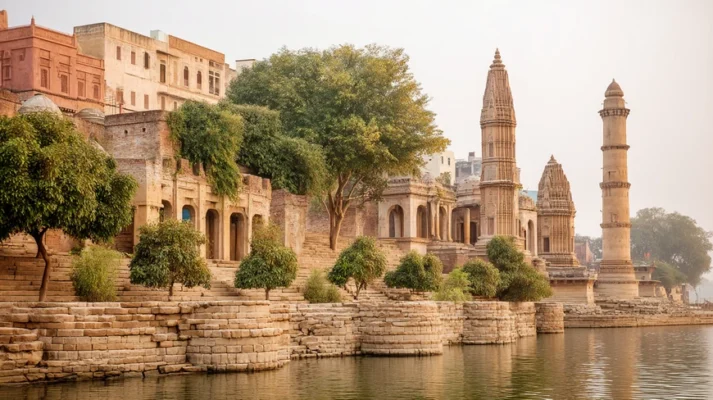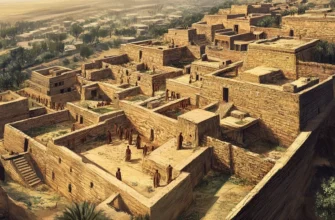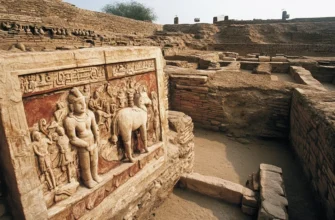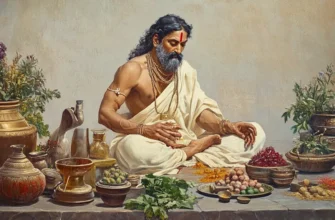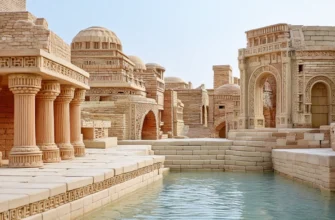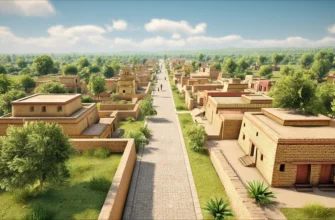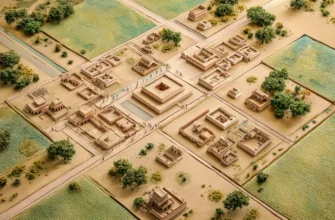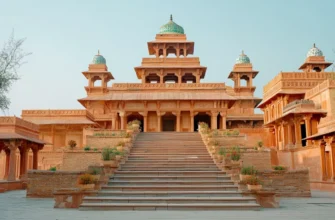Varanasi is one of the oldest cities in the world, continuously inhabited for over 3,000 years. Located on the banks of the sacred Ganges River, it is considered the spiritual capital of India.
The city plays an important role in Hinduism – it is believed that bathing in the Ganges cleanses sins, and death in Varanasi grants moksha – liberation from the cycle of rebirth. There are hundreds of temples and ghats – special steps leading down to the river where rituals are performed.
In addition to Hinduism, Varanasi is an important place for Buddhists, as it was nearby, in Sarnath, that Buddha gave his first sermon. The city is also famous for its crafts, classical music, dance, and festivals.
Today, Varanasi attracts pilgrims and tourists from all over the world, preserving a unique blend of history, religion, and culture.
History of Varanasi
Varanasi is one of the oldest cities in the world, having existed continuously for over 3,000 years. It is mentioned in Vedic texts and is considered a sacred place for Hindus, Buddhists, and Jains.
According to legend, the city was founded by the god Shiva himself, who made it a center of spiritual enlightenment. In many sacred texts, Varanasi is described as the “city of light” and a place where one can attain moksha (liberation from rebirth).
Archaeological finds confirm that Varanasi existed as early as the 2nd millennium BC. Even then, it was an important center of trade, crafts, and spiritual life.
In the 6th century BC, near Varanasi, in Sarnath, Buddha gave his first sermon after enlightenment, which made the region important for Buddhists.
During the Middle Ages, the city was destroyed by conquerors, including Mahmud Ghazni and the Mughals. Some temples were destroyed and rebuilt as mosques. During British colonization, Varanasi remained a religious center, and in 1910 it received the status of an autonomous principality.
Today, the city is one of India’s major tourist and pilgrimage centers, preserving a unique blend of history, spirituality, and culture.
Legends and mythology
Varanasi is one of the oldest cities in the world, and its history is closely linked to Hindu mythology. According to legend, the city was founded by the god Shiva himself, who chose this place as his earthly abode. He settled here with his wife Parvati and introduced people to yoga, astrology, and the Vedic scriptures.
In the Vedas and Puranas, Varanasi is mentioned as a city that existed before the beginning of time. It is believed that it is not subject to the laws of the world, as the god Shiva is always present here in his spiritual form. The name of the city comes from two rivers, the Varanasi and the Asa, which flow into the Ganges. According to one legend, the god Vishnu created these rivers to mark the boundaries of the sacred city, which would become a place of purification and spiritual growth for people.
There is a legend that Varanasi became the site of a dispute between Shiva and Brahma. In his anger, Brahma cursed the city, saying that it would be destroyed many times. But Shiva promised that Varanasi would always be reborn and remain the spiritual heart of the world. The sacred river Ganges, which flows through Varanasi, also has a divine origin. It descended from heaven to Earth thanks to King Bhagiratha, and Shiva accepted its flow onto his hair to save the world from destruction. It is believed that bathing in the waters of the Ganges in Varanasi washes away all sins and ensures the salvation of the soul.
These stories make Varanasi not just a city, but a place outside of time, symbolizing spiritual purification, wisdom, and immortality.
Archaeological finds
Archaeological finds indicate that Varanasi is one of the oldest continuously inhabited cities in the world. Excavations have shown that the first settlements in this area existed as early as the second millennium BC. Artifacts found, such as pottery, tools, and remains of dwellings, indicate a developed culture engaged in trade, crafts, and ritual practices. Among the most important archaeological discoveries in Varanasi are ancient brick structures that may have been temples or residential complexes.
Coins, seals, and inscriptions on stone indicate that the city was an important religious and commercial center during the Mauryan and Gupta empires.
Researchers are particularly interested in Sarnath, a place near Varanasi where Buddha delivered his first sermon. The ruins of stupas, monasteries, and Ashoka’s pillars have been found here, confirming the existence of a powerful Buddhist community in the region.
Archaeological finds prove that Varanasi not only survived for thousands of years but also witnessed the development of various civilizations, remaining a center of spirituality, culture, and science.
Religious significance
Varanasi has enormous religious significance and is considered a holy city for Hinduism, Buddhism, and Jainism. In Hinduism, it symbolizes spiritual purification and liberation from the wheel of samsara. The city is believed to have been founded by the god Shiva and is therefore a place of his eternal presence. Varanasi is also known for its ghats, steps leading down to the Ganges River, where pilgrims perform ritual ablutions, and cremations at Manikarnika Ghat help souls achieve moksha, or final liberation.
For Buddhists, Varanasi is of special significance due to its proximity to Sarnath, where Buddha delivered his first sermon after achieving enlightenment. This place became the center of early Buddhism, and it is home to ancient monasteries and stupas built during the reign of Emperor Ashoka.
Jains also consider Varanasi sacred because it is the birthplace of Parsvanatha, the 23rd tirthankara, one of the main teachers of this religion.
Today, Varanasi remains an important religious center, where millions of pilgrims arrive every year to receive blessings, perform rituals, and experience the unique spiritual atmosphere of a city that combines ancient tradition and modernity.
Varanasi in Hinduism
Varanasi is the holiest city in Hinduism and has a special place in the Vedic tradition. It is believed to have been founded by the god Shiva himself and is the site of his eternal presence. In sacred texts such as the Skanda Purana and the Kashi Khandha, Varanasi is described as a center of spiritual purification where the soul can attain moksha, or liberation from the cycle of rebirth.
Every year, millions of pilgrims come to Varanasi to perform ritual ablutions in the Ganges. The water of this river in the city is believed to have special powers to cleanse sins, and death in Varanasi grants liberation of the soul. Manikarnika Ghat is the main cremation site, where, according to legend, an eternal fire burns, lit by Shiva himself.
The city is also a center of Vedic knowledge and Sanskrit education. It is home to one of the most important temples of Hinduism, Kashi Vishwanath, dedicated to Shiva. In addition, Varanasi has hundreds of other temples dedicated to various deities, making it an important center of religious life.
Every day, grand rituals take place on the banks of the Ganges, including the evening Gang Aarti ceremony, during which lit lamps are lowered into the water to the sound of mantras. Varanasi symbolizes the continuity of traditions, the connection between gods and people, and has remained the heart of Hinduism for thousands of years.
A city for Buddhists and Jains
Varanasi is sacred not only to Hindus but also to Buddhists and Jains, as it played an important role in the formation and spread of these religions.
For Buddhists, the city has special significance thanks to Sarnath, a place located near Varanasi. It was here, in Isipatana Park, that Gautama Buddha, after achieving enlightenment, delivered his first sermon on the Four Noble Truths and the Eightfold Path. Sarnath became one of the main centers of Buddhism, where stupas, monasteries, and the famous pillars of Emperor Ashoka were erected, confirming the state’s support for Buddhism. Today, Sarnath remains an important place of pilgrimage for Buddhists from all over the world.
For Jains, Varanasi is sacred because it is the birthplace of Parvhat, the 23rd tirthankara (spiritual teacher) of Jainism. The city has several Jain temples dedicated to him, which attract pilgrims and seekers of spiritual enlightenment.
Thus, Varanasi is a multi-religious center that unites different spiritual traditions while preserving its sacred atmosphere for Hindus, Buddhists, and Jains.
Main attractions
Varanasi is a city steeped in history, spirituality, and unique architecture. It attracts millions of pilgrims and tourists with its temples, ghats, and religious centers.
Kashi Vishwanath Temple is one of the most important temples in Hinduism, dedicated to the god Shiva. It is believed that visiting this place brings blessings and leads to spiritual liberation.
Varanasi ghats are the heart of the city, where ritual ablutions, meditation, and cremations take place. The most famous of these are:
Dasashemmedhi Ghat – the site of the grand evening ceremony of Ganga Aarti.
Manikarnika Ghat – the main cremation site, where, according to legend, an eternal fire burns.
Assi Ghat is popular among yogis and spiritual seekers.
Sarnath is a sacred place for Buddhists, where Buddha delivered his first sermon. Here you will find the Dhamek Stupa, the ruins of ancient monasteries, and a museum with Ashoka’s pillar.
Durga Temple – known as the “Red Temple” because of its color. Dedicated to the goddess Durga, it is considered a very powerful place of energy.
Tulsi Manas Temple – dedicated to Rama and an important center for devotees of the Ramayana.
Ramnagar Fort is the residence of the former maharajas of Varanasi and contains a museum with royal artifacts, weapons, and ancient manuscripts.
Varanasi is a city where every corner breathes history and spirituality, and its sights make it a unique place of pilgrimage and cultural heritage.
Culture and traditions
Varanasi is not only the spiritual center of India, but also a hub of rich culture, ancient traditions, and art. Its unique atmosphere has been shaped over centuries, combining religious rituals, classical music, crafts, and festivals.
Music and dance
Varanasi is the birthplace of classical Indian music. It was here that the legendary musician Ravi Shankar was born, who made Indian sitar music famous throughout the world. The city is the center of the “drupad” singing style and classical Indian ragas, which are performed in local temples and at festive events.
Crafts and arts
Varanasi is famous for the production of silk saris known as “Benares saris.” They are decorated with intricate gold and silver patterns, making them some of the most valuable in all of India. The city is also known for its brassware, clay sculptures, and traditional Hindu masks.
Festivals and holidays
Varanasi celebrates numerous religious and cultural festivals every year:
Diwali – the festival of lights, when the city is illuminated by thousands of lamps.
Holi is a colorful festival of colors symbolizing the victory of good over evil.
Dev Diwali is a grand ceremony of lighting fires on the ghats of Varanasi.
Maha Shivaratri is a festival in honor of the god Shiva, who is especially revered in Varanasi.
Daily rituals
A special feature of Varanasi’s culture is the daily Gang Aarti ceremony, a ritual worship of the Ganges River with lit lamps and chanting of mantras. Pilgrims also perform ablutions, pray in numerous temples, and participate in traditional processions.
The culture of Varanasi is a blend of religion, art, and everyday life, making it a unique city that continues to preserve its ancient traditions in the modern world.
Modern Varanasi
Modern Varanasi remains an important spiritual and cultural center where ancient traditions blend harmoniously with modern life. The city is actively developing, preserving its religious status and attracting millions of pilgrims and tourists. The infrastructure is gradually being modernized, with new roads, hotels, and transport links appearing, and Benares Hindu University continues to be one of the country’s leading educational institutions.
Varanasi’s economy is largely dependent on tourism, crafts, and religious practices. The production of the famous Benares saris is one of the main industries, and local silk products are prized all over the world. Pilgrims come to the city to visit shrines, participate in rituals and ablutions in the sacred Ganges, while tourists seek to experience the unique atmosphere of the world’s oldest city.
Varanasi also faces modern challenges such as overpopulation, pollution of the Ganges and the need to preserve historical monuments. State and local initiatives are aimed at cleaning up the river, developing infrastructure, and maintaining ecological balance.
Today, Varanasi is a city of contrasts, where ancient temples stand alongside modern buildings, narrow streets are filled with the sounds of mantras, and markets are overflowing with colorful goods. It remains a place where everyone can feel the pulse of history, the spirit of religion, and the living energy of eternity.
Conclusion
Varanasi is not just a city, but a living history, a spiritual center, and a cultural treasure trove that preserves traditions dating back thousands of years. Its uniqueness lies in its deep religious significance for Hindus, Buddhists, and Jains, in the sacred rituals on the banks of the Ganges, in the magnificent temples, and in the rich heritage of arts and crafts. Here, life and death, faith and science, antiquity and modernity intertwine.
Varanasi continues to be a city that inspires, transforms, and teaches. It attracts pilgrims, seekers of wisdom, artists, and travelers from all over the world. Despite the challenges of modern life, the city retains its authenticity and remains a symbol of spiritual quest and cultural immortality. Varanasi is the heart of India, where every stone, every temple, and every wave of the Ganges tells a story of eternity.
